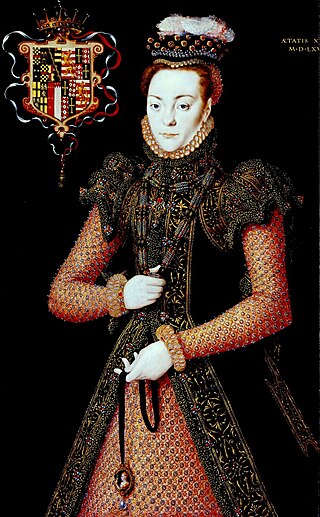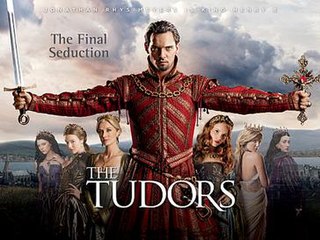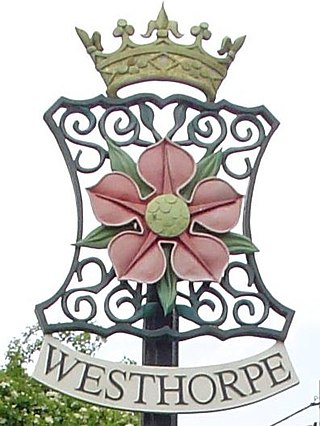
Mary Tudor was an English princess who was briefly Queen of France as the third wife of King Louis XII. Louis was more than 30 years her senior. Mary was the fifth child of Henry VII of England and Elizabeth of York, and the youngest to survive infancy.

Charles Brandon, 1st Duke of Suffolk was an English military leader and courtier. Through his third wife, Mary Tudor, he was brother-in-law to King Henry VIII.

Henry Grey, Duke of Suffolk, 3rd Marquess of Dorset, was an English courtier and nobleman of the Tudor period. He was the father of Lady Jane Grey, known as "the Nine Days' Queen".

Donnington Castle is a ruined medieval castle, situated in the small village of Donnington, just north of the town of Newbury in the English county of Berkshire. It was founded by Sir Richard Abberbury the Elder in 1386 and was bought by Thomas Chaucer before the castle was taken under royal control during the Tudor period. During the First English Civil War the castle was held by the royalist Sir John Boys and withstood an 18-month siege; after the garrison eventually surrendered, Parliament voted to demolish Donnington Castle in 1646. Only the gatehouse survives. The site is a scheduled monument under the care of English Heritage.

Stoke-by-Nayland is a village and civil parish in the Babergh district, in the county of Suffolk, England, close to the border with Essex. The parish includes the village of Withermarsh Green and the hamlets of Thorington Street and Scotland Street. The village has many cottages and timber-framed houses, all surrounding a recreation field. Possibly once the site of a monastery, the population of the civil parish was 703 at the 2001 Census, falling to 682 at the 2011 Census.

Frances Grey, Duchess of Suffolk, was an English noblewoman. She was the second child and eldest daughter of King Henry VIII's younger sister, Princess Mary, and Charles Brandon, 1st Duke of Suffolk. She was the mother of Lady Jane Grey, de facto Queen of England and Ireland for nine days, as well as Lady Katherine Grey and Lady Mary Grey.

Eleanor Clifford, Countess of Cumberland, also known as Elyanore Clifford was the third child and second daughter of Charles Brandon, 1st Duke of Suffolk and Princess Mary Tudor, the Dowager Queen consort of France. She was a younger sister of Lady Frances Brandon and an elder sister of Henry Brandon, 1st Earl of Lincoln. She was also a younger paternal half-sister of Lady Anne Brandon and Lady Mary Brandon from her father's second marriage. After her mother's death in 1533, her father remarried to Catherine Willoughby and Eleanor became an elder half-sister of Henry Brandon, 2nd Duke of Suffolk and Charles Brandon, 3rd Duke of Suffolk.

Anna of Lorraine was a princess of the House of Lorraine. She was Princess of Orange by her first marriage to René of Châlon, and Duchess of Aarschot by her second marriage to Philippe II of Croÿ.

Katherine Brandon, Duchess of Suffolk, suo jure12th Baroness Willoughby de Eresby, was an English noblewoman living at the courts of King Henry VIII, King Edward VI and Queen Elizabeth I. She was the fourth wife of Charles Brandon, 1st Duke of Suffolk, who acted as her legal guardian during his third marriage to Henry VIII's sister Mary. Her second husband was Richard Bertie, a member of her household. Following Charles Brandon's death in 1545, it was rumoured that King Henry had considered marrying Katherine as his seventh wife, while he was still married to his sixth wife, Catherine Parr, who was Katherine's close friend.

Chenies Manor House in the parish of Chenies in Buckinghamshire, England, is a Tudor Grade I listed building once known as Chenies Palace, although it was never a royal seat nor the seat of a bishop. It was held by the Cheney family since 1180 and passed by marriage successively to the Semark and Sapcote families and thence in 1526 to the Russell family, Earls of Bedford, later Dukes of Bedford, by whom it was held for several centuries. Although the Russells soon abandoned Chenies as its main seat in favour of Woburn Abbey in Bedfordshire, Chenies parish church remains the site of the private "Bedford Chapel", the mausoleum still in use by that family.

Henry Clifford, 2nd Earl of Cumberland was a member of the Clifford family, seated at Skipton Castle from 1310 to 1676. His wife was Lady Eleanor Brandon, a niece of King Henry VIII.After her death, he married Anne Dacre.

The Tudors is a British-Canadian historical fiction television series set primarily in 16th-century England, created and written by Michael Hirst and produced for the American premium cable television channel Showtime. The series was a collaboration among American, British, and Canadian producers, and was filmed mostly in Ireland. While named after the Tudor dynasty as a whole, it is based specifically upon the reign of King Henry VIII.

Wingfield Castle in the parish of Wingfield in Suffolk, England is a fortified manor house which was the ancestral home of the Wingfield family and their heirs, the de la Pole family, created Earls and Dukes of Suffolk. It is now a private house. Sir John de Wingfield, of Wingfield, chief administrator to Edward the Black Prince (1330–1376), was the last male of his line, whose daughter and heiress Catherine Wingfield married Michael de la Pole, seated at Wingfield Castle, who in 1385 was created Earl of Suffolk. His descendant Edmund de la Pole, 3rd Duke of Suffolk (1472–1513) was forced to surrender his dukedom in 1493. It was resurrected by King Henry VIII in 1514 for his favourite Charles Brandon, 1st Duke of Suffolk (1484–1545), who although he had no close connection with Wingfield Castle and the county of Suffolk, was a great-grandson of Sir Robert Wingfield, of Letheringham in Suffolk, about 12 miles south of Wingfield.

Westhorpe is a linear village and civil parish in the Mid Suffolk district of Suffolk, England. The village is 13 miles (21 km) from the town of Bury St. Edmunds, 7 miles (11 km) from Stowmarket, and 1 mile (1.6 km) from the villages of Wyverstone and Finningham.

Thomas Grey, 2nd Marquess of Dorset was an English peer, courtier, soldier and landowner of the House of Grey.
Sir Henry Jerningham KB was an English courtier during the Tudor period. He was a Gentleman Pensioner during the reign of Henry VIII. In the succession crisis of 1553 he was one of the foremost supporters of Mary Tudor, and after her accession was one of her most trusted servants, being appointed Vice-Chamberlain of the Household, Captain of the Yeomen of the Guard, and a member of the Privy Council.
Lady Anne Brandon, Baroness Grey of Powys was an English noblewoman, and the eldest daughter of Charles Brandon, 1st Duke of Suffolk by his second wife, Anne Browne. Anne's mother had died in 1511. In 1514, Anne's father secured a place for her at the court of Archduchess Margaret of Savoy. While Anne was abroad, her father married Mary Tudor, the widowed Queen consort of Louis XII of France and the youngest sister of Henry VIII.

Lady Mary Brandon was an English noblewoman, and the daughter of Charles Brandon, 1st Duke of Suffolk, by his second wife, Anne Browne. Mary was the wife of Thomas Stanley, 2nd Baron Monteagle, by whom she had six children.
Sir William Sidney was an English courtier under Henry VIII and Edward VI.
Sir Arthur Hopton of Cockfield Hall in Yoxford, Suffolk was an English knight, landowner, magistrate, and Member of Parliament.
















